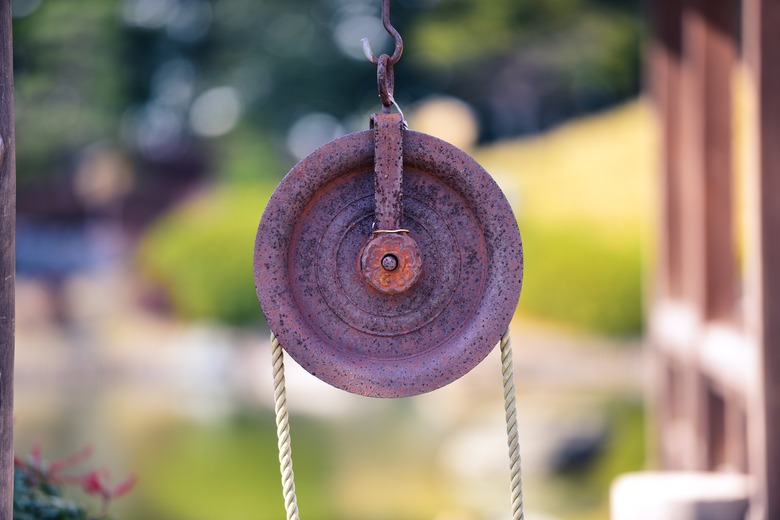How To Calculate The Speed Of Two Different Pulleys
Pulleys provide a simple way to transfer power from one shaft to another. By using pulleys with various diameters, you can specify the mechanical advantage and the relative speeds of the shafts. As with other simple machines, pulleys may exhibit a mechanical advantage by trading distance for force. A small fast-moving pulley, for instance, can transfer a greater force to a large slow-moving pulley as a trade-off for its rotational distance. In other words, if the output pulley were smaller, the input pulley wouldn't need to rotate as much to get the same output shaft speed.
1. Determine the Drive Speed
Determine the drive speed of the drive shaft. How you do this will vary greatly depending on the equipment you're working with. Some engines, motors or devices may have a tachometer. Alternatively, you may find information on the manufacturer's website or in the documentation.
2. Measure the Pulley's Pitch Diameter
Measure the drive pulley's pitch diameter. The pitch diameter is the point where little or no slippage occurs between the belt and the pulley. Although it's very difficult to determine accurately, in most cases it will be somewhere in between the base and the top of the pulley's groove. Inspect the belt while it's off of the pulley by bending it. The outer surface will stretch, and the inner will compress. The pitch diameter coincides with the point where neither compression nor stretching occurs.
3. Calculate the Pulley Ratio
Calculate the pulley ratio by dividing the pulley's pitch diameter by the pitch diameter of the drive pulley. For example, suppose the drive-shaft has a diameter of 2.2 inches, and two pulleys driven by the belt have diameters of 4.4 inches and 2.8 inches. The first ratio is:
\(\frac{4.4}{2.2}=2\)
and the second ratio is:
\(frac{2.8}{2.2}=1.27\)
4. Calculate the Speeds
Calculate the speed of each pulley by dividing the drive speed by the pulley ratio. For example, given a drive speed of 750 RPM, the speed of the first pulley is:
\(\frac{750}{2}=275\text{ RPM}\)
and the speed of the second pulley is:
\(\frac{750}{1.27}=591\text{ RPM}\)
Things Needed
- System of pulleys
- Belt
TL;DR (Too Long; Didn't Read)
All pulley systems operate on the same principle, whether they use a belt, rope or chain. For example, the speeds of all the pulleys in a block an tackle system can be calculated by finding the ratios of each pulley's diameter.
When dealing with gears or sprockets, the most accurate way to determine relative speeds is to ignore pitch diameter altogether and simply count the number of teeth on the gears or sprockets. The number of teeth on a gear or sprocket is exactly proportional to the pitch diameter. Therefore, the gear ratio equals the number of teeth on the gear divided by the number of teeth on the driver gear.
Cite This Article
MLA
Gamble, Mike. "How To Calculate The Speed Of Two Different Pulleys" sciencing.com, https://www.sciencing.com/calculate-speed-two-different-pulleys-8459769/. 8 November 2020.
APA
Gamble, Mike. (2020, November 8). How To Calculate The Speed Of Two Different Pulleys. sciencing.com. Retrieved from https://www.sciencing.com/calculate-speed-two-different-pulleys-8459769/
Chicago
Gamble, Mike. How To Calculate The Speed Of Two Different Pulleys last modified March 24, 2022. https://www.sciencing.com/calculate-speed-two-different-pulleys-8459769/
